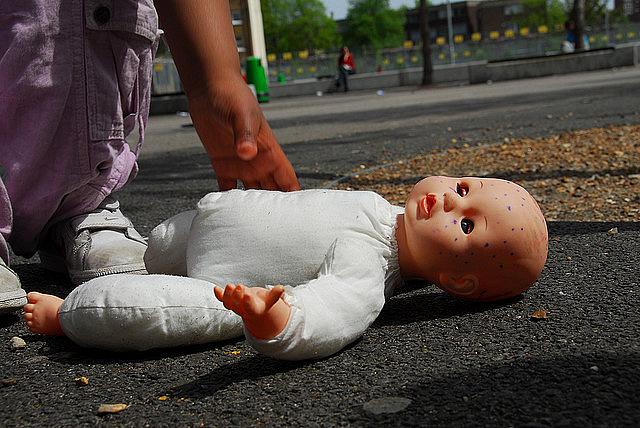A view from the front lines of L.A.’s overcrowded foster care system

Three-and-a-half-year-old Dylan was tiny, feisty and freckled with tousled blond hair. He looked like a real-life Dennis-the-Menace. His mom brought him to the pediatric clinic because he had tried to smother his 2-week-old sister. She didn’t know what to do with him, and frankly neither did we. It was 5 p.m. and the clinic was closing. So, we admitted him to the hospital to keep everyone, including Dylan, safe — a “social admission.”
Back in the early 2000s, that’s what we called hospitalizations for kids we couldn’t send home. Social admissions had to end due to the rising costs of hospitalization, and billing services called me to task for admitting Dylan. I simply asked them, “Where do you want me to send him?” In their minds, he was the Department of Children and Family Services’ (DCFS) problem, not the hospital’s.
Our social worker, Elizabeth, called DCFS and they started an investigation. Dylan’s mom admitted she hated Dylan. While she was pregnant, she had an ugly break-up with Dylan’s dad and she never wanted him. Dylan knew he wasn’t wanted; he couldn’t tolerate seeing the love he so desperately needed being freely given to his newborn sister. He wanted her gone from his life, and so he lashed out in a fit of anger.
The next day, Dylan’s mom arrived with an Elmo-decorated mini-suitcase containing all of Dylan’s possessions: a toothbrush, one pair of tattered jeans, pajamas and a few T-shirts. Without emotion, she handed the suitcase to our social worker and told her that she could give Dylan to child services — she wasn’t going to take him home.
But it was apparent that Dylan’s mom had abandoned him long before leaving him in the hospital that day. Foster families didn’t want him either — he had already tried to harm a baby, so he was labeled as a “high-need placement.” He would have to go to a home with no other children and no animals — a rarity. So he became a fixture in the pediatric ward until a home could be found.
Placements for children such as Dylan are increasingly difficult to find in Los Angeles County. Since 2000, the number of available foster homes in the county has decreased from 20,000 to about 9,000, and few of those take high-need children such as Dylan. Those are the kids that end up at LAC + USC Medical Center’s Welcome Centers, holding facilities where maltreated children can stay until foster care placements are found.
Last week, a Los Angeles Times headline read, “L.A. County’s foster center should be closed immediately, panel says.” The story reported that the main violations of the Child Welcome Center (for children younger than 12) and the Youth Welcome Center (for teens) stemmed from overcrowding. The centers were set up to house children for 24 hours until a placement could be found. The idea was that the centers would be preferable to having kids sit in DCFS offices for days or linger in costly acute-care hospitals.
But, as the Times’ Garrett Therolf reported, the centers didn’t work as planned; too many kids were being housed for too long because there was nowhere else for them to go. No child is ever turned away. The Welcome Centers were supposed to provide kids in need with a way station, but instead they opened the doors to a new round of problems for the system’s most vulnerable foster kids.
The Times article tells the children’s stories with tenderness and conveys the plight of the Welcome Centers with compassion. But the accompanying photos paint a misleading picture. One of the photos shows the Youth Welcome Center through a chain-link fence and another shows police walking a handcuffed teen into a squad car. Both pictures are in black-and-white and suggest a prison. In reality, the chain-link fence is on the basketball court to keep balls from going over the edge and the centers are clean and safe. Their main flaw: too small to meet demand.
Often, the public thinks of difficult-to-place kids as the teens in the Times’ photos. Some do have rap sheets, with offenses such as drug use, prostitution, defiance or mental illness. Those kids are challenging, and most started like Dylan – with no one to love them. But they all need a home, or at least, a safe place to sleep.
The expert panel cited in the Times’ article called for closure of the facilities immediately, and recommended longer-term solutions — chief among them is the need for more foster homes. State officials sued Los Angeles County this year over the crowded conditions in the centers, and in response, the county plans to bring them up to code for longer stays, which is likely still not enough to meet demand. The article describes the centers as “a bleak last stop for lost youth.” The bleakness is real — not because of the conditions at the centers, but because of the life circumstances that have left the kids who end up in them with no other options.
There are no quick fixes for such an overburdened system. But, there are reasonable stopgaps to allow time to develop real solutions. The county is upgrading the Welcome Centers to permit longer stays, and they are working with foster care agencies to create 30-day emergency shelters. Band-Aids, but a start. The county can do more to cultivate quality foster homes and to provide foster caregivers with adequate training and resources to care for traumatized children. But if we're really going to tackle the problem, we’ll need to invest more in programs that prevent child abuse as well as early interventions that help families stay together, so that welcome centers wouldn’t be needed. Ultimately, the most welcoming place for children is a safe, nurturing family.
[Photo by Elliot Moore via Flickr.]
